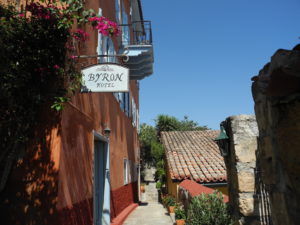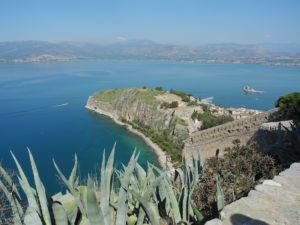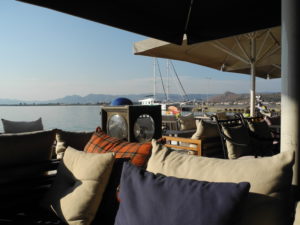Although I’d been to Greece twice before, I wasn’t familiar with the town of Nafplio (also spelled Nafplion) until four members of my family and I spent several days there recently to attend a baptismal ceremony and celebration for the baby daughter of some friends. (More on that in my next post.)
Nafplio is about a two-hour drive from the airport in Athens, and is located at the northern end of the Peloponnesian Peninsula, where the Peloponnesian War pitted the Athenians versus the Spartans in the 5th century BC.
The militaristic Spartans prevailed over the once-dominant but philosophically minded Athenians, dealing a fatal blow to the golden age of ancient Greek democracy.
It was kind of like the Michigan State Spartans football team taking on the UC-Santa Cruz Banana Slugs. Ouch.
Nafplio, though, redeemed the honor of the Peloponnese by becoming the capital of the First Hellenic Republic following the Greek revolution against the Ottoman Empire in 1821. That year marked the beginning of what we know now as modern Greece, which had previously been occupied by the Turks, Venetians, and other powers.
It remained the Greek capital until 1834, when it was moved to Athens. Today it’s a seaside resort blessed with Venetian-style plazas, narrow winding Turkish-style streets, and modern-day Mediterranean-style cafes, restaurants and hotels, many with views of the harbor — where a small fortress that once guarded against invaders sits serenely in the water.
A Resort With History
The town offers the perfect combination of sun, sea, scenery, Greek cuisine, nearby beaches, and, for good measure, plenty of fascinating history.

The Lord Byron Hotel in Nafplio honors the English poet who died fighting for Greek independence. Photo by Clark Norton
For starters, it’s within easy driving distance of some of Greece’s most significant archaeological sites:
- Epidaurus, site of an ancient theater still used for performances;
- Corinth, site of the 6th century BC Temple of Apollo and a Christian pilgrimage site as well — the Apostle Paul directed his two epistles to the Corinthians to its residents;
- Mycenae, an archaeological treasure trove and site of an ancient civilization that dominated what is now modern-day Greece;
- and Argos, home of the Argonauts, as in Jason and the Argonauts.
But you don’t have to leave Nafplio to get your history fix.
Looming on a mountain high above the old town, which occupies a small peninsula jutting into the Aegean Sea, is a medieval fortress that offers panoramic views, massive walls meant to hold off invaders, and spooky cells where prisoners were kept in isolation.
The fortress was overrun twice, however, once by the Turks and later by the Greeks, who took the same largely unguarded back-door route to surprise the sleeping soldiers within. Having pulled the same trick themselves a century earlier, you’d think the Turks would have learned their lesson.
Of course, that predated google and YouTube.
You can climb to the fortress via 999 steps from town, or drive up to the entrance. We chose the latter option — due to lack of time, of course, including cafe sitting and other obligations.
Other Obligations
Shortly after we arrived and checked into our hotel, we began our exploration of Greek cuisine at a seaside restaurant.
Sitting outdoors with a sea view, we dined on tzaziki (a Greek dip served with pita bread); traditional Greek salad (tomatoes, sliced cucumbers, red onion, and olives topped with a large hunk of feta cheese and dressed with olive oil, wine vinegar, salt, and Greek oregano); eggplant salad; grilled octopus; fried calamari; kolokithokeftedes (fried zucchini balls and yes, that’s the spelling; they’re also called courgette balls); dolmas (stuffed grape leaves), and tiny whole fried fish.
Wine, beer, and water were also consumed. (For beer, I would recommend the Mythos, a nice Greek lager.)
Fortunately our friend Nick, a second generation Greek-American and father of the baby to be baptized, was there to order for us in Greek, although English is widely spoken. (My general travel experience has been that when food is ordered in the native language, it’s cooked and served in a more authentic fashion.)
In any event, the food was delicious. I was especially fond of the kolokithokeftedes, though, since I couldn’t pronounce it, I couldn’t really compliment the chef.
Since we’d had no lunch after flying into Athens and driving straight to Nafplio, we ate quite early, around 5:30 p.m. The restaurants and even most of the cafes were all deserted at that hour, and we feared that Greek tourism was really hurting.
Our fear deepened when we went for a seaside walk around 7:30 and there were still few diners to be seen, though the cafes were a tad busier and a number of people were swimming in the sea.
Then, when we returned from our walk at 9 p.m., near sunset, the seaside promenade was swarming with people strolling, the cafes were hopping and the restaurants were starting to fill.
We stopped at a cafe for a drink to enjoy the passing scene, and by the time we were ready to pass out from sleepiness after our overnight flight and napless day, the restaurants were jammed and boisterous..It was about 10 p.m., and, as we discovered, that’s just when Greeks are starting to order their appetizers.
On our way back to the hotel, with Nafplio now a beehive of activity, we no longer worried about the state of Greek tourism.
Certainly not in Nafplio, which I can’t believe had never previously been on my radar. It is now.
Next: My Big, Fat Greek Baptism














Leave a Reply